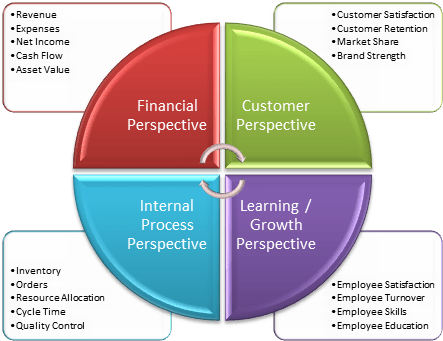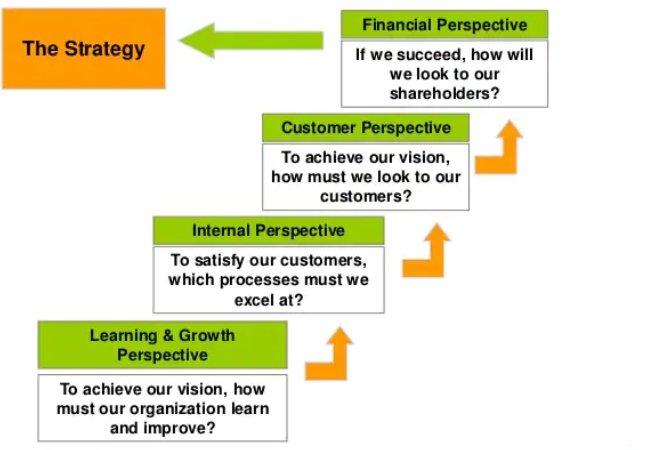The balanced scorecard is a management system that aims to translate the strategic objectives of the organization into a set of performance objectives which, in turn, are measured, monitored and changed if necessary to ensure that the strategic objectives of the organization are met.
The main premise of the balanced scorecard approach is that the financial accounting metrics that companies have traditionally followed to monitor their strategic goals are not enough to keep the company on track. Financial results describe what has happened in the past, not where the business is or should be.
Want to know more about the balanced scorecard? keep reading this article
Definition and History of the Balanced Scorecard

Before diving deep into what the Balanced Scorecard is all about, it’s important to understand the context and concepts behind the management and monitoring tool that professors Robert S. Kaplan and David Norton created in their famous 1992 Harvard Business Review article “ The Balanced Scorecard: Measures that drives performance. “
At that time there was a perception that organizational benchmarking methods were becoming obsolete and inadequate. At the end of the professor’s studies, they need a more precise method of measuring company performance, in the end they develop an efficient support system for decision making, to help strategic management.
One of the key points of the balanced scorecard is to expand the evaluation of prospect performance which has always been very focused on the financial aspect.
Therefore, the description in the balanced scorecard measurement can be determined as follows:
A tool to monitor strategic decisions taken by companies based on pre-defined indicators and which must penetrate through at least four aspects – finance, customers, internal processes and learning & growth.
Thus, the company has extended measurement and monitoring capabilities, allowing all relevant supply chain points to be measured.
Also, It brings a significant increase in the company-wide understanding of their strategy defined by top management, by involving every employee in the process. This is done through the development of a strategic map.
In addition, in the example of management using the balanced scorecard method, there are several strategic maps that become clearer when management summarizes each method of measuring organizational performance and its effect on the achievement of business goals.
Professors Robert Kaplan and David Norton argue:
“The communication of the Balanced Scorecard occurs through a logical structure, based on the management of predetermined objectives; enables managers to reallocate physical, financial and human resources to achieve strategic objectives. More than just a performance measurement tool, the Balanced Scorecard is a strategy translator and performance communicator. “
A good business process management system will always be reliable in monitoring, managing and assisting in decision making in your company.
Balanced Scorecard Function
1. Give structure to the strategy
Unlike financial or HR management, organizations often talk about organizational performance and strategy in a variety of different and unique ways.
Thus, there are many different approaches to strategic management. The Balanced Scorecard is a logical and structured way to help your organization’s leaders ensure that all areas of the organization are covered in an easy-to-understand way.
It helps keep your goals central, uses custom measures to track progress, and follows initiatives to track the actions and structures of those who use the knowledge and data collected.
2. Facilitate strategic communication in business
The business plan is designed to clearly convey the strategic plan. It is a good and simple visual aid used to align each department or content with the aim of achieving high-level business goals.
When implemented correctly, it means it will:
- Give employees clear goals to keep in mind while working on actions.
- Help employees identify key goals.
- Enables employees to better understand the strategic elements that require addressing
- Allows employees to see how goals affect one another.
3. It aligns departments and contents
If implemented properly, all content and departments should align with the same strategy, and the Balanced Scorecard facilitates this process.
With the structure built into the balanced scorecard, you can link your critical goals with the overall company goals.
In addition, you can see how your measurements can be reviewed and applied to enterprise-level measures, how projects are linked to enterprise-level projects, and more. The balanced scorecard also provides the structure needed when large projects are distributed across multiple contents.
4. It helps your employees see how their dual goals relate to the organization’s strategy
Using the Strategy Focused Organization framework, the balanced scorecard enables individuals to align their goals across the organization.
For example, an employee who sets regular performance goals for an annual personal review and can relate their goals to their content or departmental goals.
So, the balanced scorecard allows all your employees to relate what they are doing to the progress of the team and the company as a whole.
5. It makes your strategy continues on track- his
Many organizations build strategic plans and put them on the shelf, never to be reviewed. The creation of a balanced scorecard framework is based on a regular review of your strategy and you can only do this if your strategy is organized.
Regular monthly or quarterly strategy review meetings, combined with annual strategy updates, will ensure you reference your strategy on a regular basis and make it the centerpiece of your management reporting process.
Reviewing your strategy will bring it to life and make it part of how you manage your organization. In addition, you will know where you are at all times in achieving your goals.
4 Perspectives in the Balanced Scorecard

There are 4 perspectives that you need to think about before designing the right balanced scorecard. Here are the 4 perspectives:
Financial Perspective
For most business organizations, profit is the top goal. Therefore, the top perspective is about financial goals and achieving sustainable profits.
Basically, any major objective related to the health and financial performance of a company can be included in this perspective. Revenue and profit are the clear goals that most organizations list in this perspective.
Other financial goals may include:
- Cost savings and efficiency (e.g., a specific goal of reducing production costs by 10% by 2020)
- Profit Margin (increasing operating profit margin, for example)
- Revenue sources (for example, adding a new revenue channel)
Customer Perspective
This perspective focuses on performance objectives related to customers and markets. In other words, if you want to achieve your financial goals, what do you really need for your customers and market?
Examples of things included in this perspective are such as:
- Customer service and satisfaction (increasing net promoter score , or reducing call center lead times , for example)
- Market share (e.g., growing market share in a particular segment or country)
- Brand awareness (e.g., increasing engagement on social media)
Internal Process Perspective
What processes do you need to follow to achieve your customer and financial goals? That is the question this perspective seeks to answer.
Here you will define internal operational goals and objectives, or in other words, what does the business need to have and what does the business need to do well to drive performance?
Examples of internal process objectives might include:
- Process improvements (e.g. streamlining internal approval processes)
- Quality optimization (eg, reducing production waste)
- Capacity utilization (using technology to increase efficiency, for example)
Learning and Growth Perspective
While the third perspective is about the concrete process side of things, this last perspective considers the more intangible drivers of performance. Because it covers such a broad spectrum, this perspective is often broken down into the following components:
- Human capital – skills, talents and knowledge (e.g., skills assessment, performance management scores, training effectiveness)
- Information capital – databases, information systems, networks and technology infrastructure (eg, safety systems, data protection systems, infrastructure investments)
- Organizational capital – culture, leadership, employee alignment, teamwork and knowledge management (e.g., staff engagement, employee net promoter score, corporate culture audit)
Example of a Balanced Scorecard in Business
The process of developing a Balanced Scorecard in a company involves several steps, the following is a summary:
- Set a clear vision of the future
- Define strategic goals
- Determine the critical success factors
- Select indicators to measure and monitor performance
- Set goals, action plans and initiatives
All 5 steps for each of the 4 perspectives.
These points, are just a few aspects of how to set goals and select indicators.
The following is an example of a strategic map generated during the development of a Balanced Scorecard project, which summarizes all the work for the organization, including objectives, targets, indicators, as well as actions and initiatives that must be undertaken and implemented.
Conclusion
That’s the complete understanding of the balanced scorecard for the progress of your business. Remember, the financial perspective is the main perspective in this plan, so make sure you use the best system in financial planning for your business.
